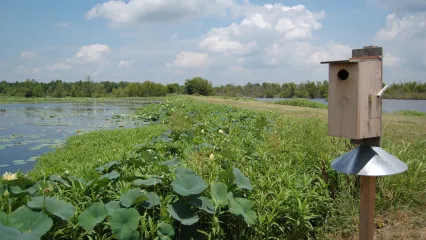
With its rich biodiversity and natural history, Red Slough is one of the best examples of how nature can re-exert itself with a nudge here and there. Manipulated by farmers in the early 20th century to produce quality crops. In the 1960's, a variety of forces: including demand for rice, a poor economy in southeast Oklahoma, and industrious farmers combined to reduce the habitat at Red Slough to a fraction of its former glory.
Red Slough WMA was acquired at the turn of the century with the goal of restoring the area’s hydrology and habitat. With this goal in mind, the Oklahoma Department of Wildlife Conservation, United States Forest Service, and Natural Resources Conservation Service created a mosaic of habitat types to serve both purposes with initial start-up assistance via Ducks Unlimited. Red Slough WMA is now co-operatively managed by the USFS, ODWC, and NRCS to provide a vast array of habitat and hydrology manipulation to maintain the rich biodiversity now present throughout the Wildlife Management Area.
The ODWC, U S Forest Service, Ducks Unlimited and Natural Resources Conservation Service had the vision that this land could be reclaimed for wildlife, and out of love for diversity and quality hunting experiences they are seeing it through.
Red Slough WMA covers 5,280 acres in McCurtain County consisting of mudflats, emergent marshes, bottomland hardwoods, areas of lowland/upland prairie, and permanent reservoirs. The entire WMA is intersected by Push Creek. In addition, roughly 600 acres have been set aside as a waterfowl refuge. No hunting is allowed in the refuge area and it is completely off-limits from October 15 to January 31.
It is still a work in progress; it took years to reduce it to agricultural land, and it will take years to return it to its native environment. Management efforts are aimed at providing the highest level of plant and animal diversity possible by focusing on annual plant production on a 3-5 year rotation. Practices consist of water level manipulation, disking, prescribed burning, herbicide application, and mowing. One or a combination of these practices are used in individual areas to maximize species diversity. native plants and invertebrates provide the majority of forage for game and non-game year-round. In addition, more than 25 miles of levees were constructed to create separate impoundments for moist soil wetland development units to better mimic the historical hydrology of the area.
Thanks to these improvements, Red Slough offers a variety of outdoor experiences for consumptive and non-consumptive users alike. Opportunities include: hunting, fishing, bird-watching, and nature photography. Red Slough is composed of diverse habitat types reflected by Red Slough’s species richness and bio-diversity.
Biologists and resource professionals have documented well over 1,000 species of flora and fauna on Red Slough WMA. With bird and plants species composing 60% of the documented species.
The area is becoming a Mecca for bird watchers anxious to check some of the numerous avian species at Red Slough off of their life list. With over 320 documented bird species, visitors have the opportunity to view roseate spoonbills, wood storks, secretive rails, passerines, and game species with peak activity periods being in the spring and fall.
Waterfowl hunters are also beginning to learn about the potential opportunities on the wildlife management area; some traveling from as far away as Minnesota, California, Florida, and Illinois to hunt the wetlands. Located on the edge of both the Central and Mississippi flyways, thousands of ducks find refuge at Red Slough each winter. According to Kevin Norton, assistant director for state conservationist programs for the NRCS, the area has become an increasingly important landmark for numerous species of waterfowl and shorebirds since the U.S. Forest Service purchased it in 1997.
"The managers have done an excellent job of increasing wetland habitat by working together and pooling resources, "Norton said. "It's fast becoming a premier birding and waterfowl hunting destination in Oklahoma."
In addition to waterfowl, Red Slough is open to archery deer and all other small game hunting. Hunters can also pursue both swamp and cottontail rabbits in the scrub-shrub habitats inundating Red Slough. Red Slough is a non-toxic shot area for all game species.
As if hunting and wildlife viewing opportunities aren't enough, Red Slough also contains 414 acres of reservoirs containing bass, sunfish, and catfish. In addition, anglers often find action in the pools and riffles of Push Creek and Norwood Creek, which dissects Red Slough. It abounds with native game and non-game fish species.
Red Slough is a unique and diverse area not only because of the multitude of species that call it home, but also because of its history and the unique partnership that made it a reality.
While you’re there
Those who are looking for more to do in McCurtain County have many options ranging from Broken Bow Lake, which produced the last state record largemouth bass, to Beavers Bend State Park, an area that every Oklahoman should visit at least once.
For additional information and area attractions:
- The U.S. Forest Service
More information about Red Slough on their website:
https://www.fs.usda.gov/recarea/ouachita/recarea/?recid=81456
(800) 722-8180
- Broken Bow Chamber of Commerce
1134 W. Martin Luther King Jr.
Broken Bow, OK 74728
(800) 528-7337
Email: chamber@pine-net.com
- Idabel Chamber of Commerce
13 North Central, Idabel, OK 74745
(580) 286-3305
www.idabelchamber.com
- Oklahoma Tourism and Recreation Department
Post Office Box 52002
Oklahoma City, OK 73152-2002
(800) 652-6552
www.travelok.com